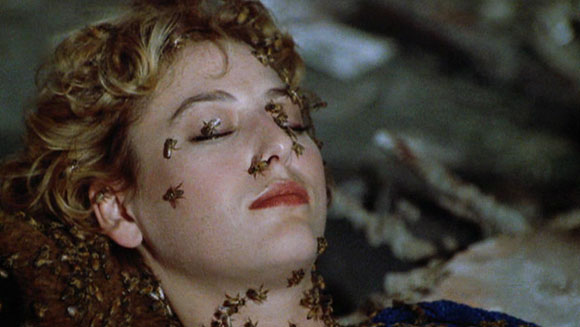 By Dean Treadway
By Dean Treadway
Contributing Writer
BOOGIE NIGHTS (1997); Dir: Paul Thomas Anderson; Writer: Paul Thomas Anderson; Starring Mark Wahlberg, Burt Reynolds, Julianne Moore, Don Cheadle, William H. Macy, John C. Reilly, Heather Graham; Taboo-La-La Series hosted by Blast-Off Burlesque at Plaza Theatre, Sat. Jan. 21; 10 PM; arrive early for a night of innuendo-laden foods, Porn Persona superstar costume contest, prizes, Rollergirl madness and a hilarious stage show with special guest Cousin Dan; age 18 & over only; trailer here.
BOOGIE NIGHTS is one of those films I love in spite of my better judgment. It’s a resolutely big-screen experience, and Atlanta moviegoers are going to have a rare opportunity to see it on the big screen at the Plaza Theater on Saturday, Jan. 21 when it appears as the feature accompanying Blast-Off Burlesque‘s saucy Taboo-La-La show starting at 10 p.m.
I can recall gendering at the beautiful one-sheet for BOOGIE NIGHTS before it was released in the fall of 1997. I marveled at its huge cast, and was excited about the subject matter – a trip through the Los Angeles porn industry of the late ’70s. I didn’t know who the writer/director Paul Thomas Anderson was at that time, having not seen his first feature, the small-time con film, HARD EIGHT, but that would soon change. The poster, though, with its intricate photo collage of characters from the film, promised an epic portrayal unlike anything ever attempted. I was extremely thrilled about seeing it.
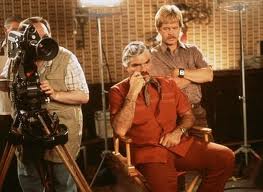
Burt Reynolds in BOOGIE NIGHTS. New Line Cinema, 1997.
In BOOGIE NIGHTS, we follow its naïve central character, Eddie Adams (Mark Wahlberg), as he is ensnared into a makeshift family of porn filmmakers and performers. He’s spotted by the patriarchal auteur Jack Horner (Burt Reynolds) as he’s performing tricks on the side at his busboy job at an L.A. nightspot. Impressed by his entire…um…package, Horner invites Eddie into the porn fold, and there his triumphs and troubles begin. Eddie’s eventual transformation into the XXX-star Dirk Diggler is followed in great detail, but this story is really a kind of connective tissue for all the many other tales the film has to offer. Julianne Moore is a top-tier porn actress battling the courts and her ex-husband over custody of their son while using Horner’s coterie of performers as sort of stand-in children. William H. Macy is a meek assistant director struggling with his wife’s brazen infidelity. John C. Reilly is an amiable second-string performer with a penchant for magic tricks who’s attempting to forge a stronger identity for himself. Don Cheadle is another beaten-down porn star who’s finding difficulty breaking into the world of legitimate business. Heather Graham is the sexy but largely innocent Rollergirl, searching for the family she can’t find at home. And Horner himself is battling pressures to convert to video rather than film – an idea he finds abhorrent (this is especially poignant now, seeing as how this might be your last opportunity to catch BOOGIE NIGHTS on 35mm). Throw into this mix Philip Seymour Hoffman as a schlubby sound guy, Luis Guzman as an enthusiastic outsider, Robert Ridgely as a troubled producer, Philip Baker Hall as an imposing moneyman, and Ricky Jay as Horner’s loyal editor, and you can get a sense of this film’s great ambition.
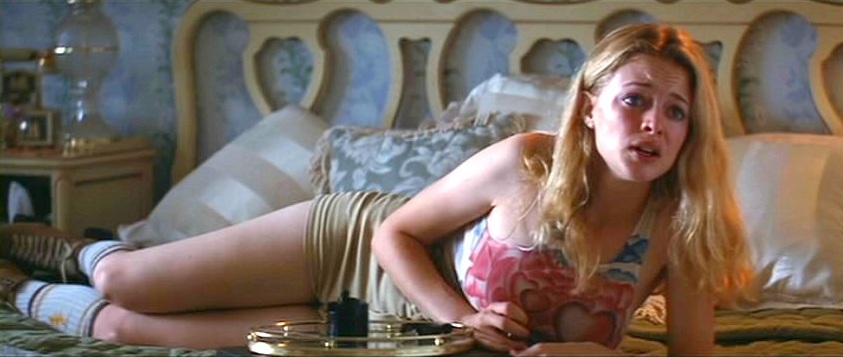
Heather Graham plays a sexy, but largely innocent Rollergirl in BOOGIE NIGHTS. New Line Cinema, 1997.
I still find moments in the film to be quite wonderful. The widescreen cinematography, by Anderson regular Robert Elswit (who would go on to win an Oscar for his work on Anderson’s THERE WILL BE BLOOD), is always vibrant and inventive, as is the ’70s-era source music score (which pairs nicely with a sad circus underscore by Michael Penn). Anderson writes dialogue for dumb people particularly brilliantly, so there’s always funny conversation going on. The period detail in the garish art direction and costume design are spot-on. I love seeing Burt Reynolds tearing into a good role, for possibly the last time, and Julianne Moore is lovingly histrionic here, as she would be in Anderson’s MAGNOLIA as well (both received supporting player Oscar nominations). As always, I find John C. Reilly to be a hoot as Reed Rothschild, and Phillip Seymour Hoffman is sweet as the crewman who gets a crush on Eddie (his tortured confession of this to the unsuspecting Wahlberg is perhaps the movie’s most shattering scene).
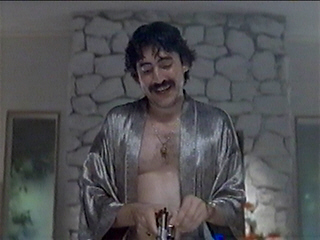
Alfred Molina in BOOGIE NIGHTS. New Line Cinema, 1997
But I also find that many parts don’t work. William H. Macy is a barely-sketched punching bag of a character. Don Cheadle’s story fails to make a deep impression (note: any time you see a character in a white suit, you can bet that thing’s gonna be covered in blood by the end of the scene). And Graham’s Rollergirl, while extremely cute, also seems thinly-written. It feels like Anderson just has too much movie here for 2 ½ hours to hold (BOOGIE NIGHTS would have been a much better TV series).
Still, though the film owes a bit too much to the GOODFELLAS style of soaring-then-crashing storytelling (with the onslaught of the 1980s being the rather too-obvious turning point), BOOGIE NIGHTS is required viewing if only for its extremely tense final third, which finds Eddie struggling with a cocaine addiction while trying to launch a hilariously ill-thought musical career (the songs, performed bravely and horribly by Wahlberg and Reilly, include the original “Feel My Heat“ and a cover of the closing song to THE TRANSFORMERS MOVIE, “The Touch“). Particularly memorable in this segment, too, is one of the great scenes in movie history, where Wahlberg, Reilly and ne’er-do-well Thomas Jane are stuck inside a free-basing coke-dealer’s house. The gun-toting dealer is played with a maniac’s energy by Alfred Molina; he’s so coked up, he has no idea that these three are planning to rip him off. With firecrackers being thrown left and right by his houseboy, he holds the guys semi-hostage as he insists on playing “Jessie’s Girl” and “Sister Christian” for them on his stereo. You’ll never hear these two songs in quite the same way again. It’s really a marvelously scary moment that puts you right there in this mess and gets your heart pounding.
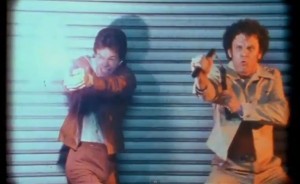
Mark Wahlberg and John C. Reilly in BOOGIE NIGHTS. New Line Cinema, 1997.
There are many other things I like about the movie: the stiffly-acted porn sequences, shot on a scratchy 16mm; the wonderful tour through one of Horner’s house parties, done in one long shot that recalls a scene out of I AM CUBA, where we follow a girl as she jumps into the pool out back, all to the tune of Eric Burdon’s “Spill the Wine”; and the final shot of the film, which recalls another Scorsese classic, RAGING BULL, but which ends with, at last, a glimpse of what made Dirk Diggler famous. I wish BOOGIE NIGHTS as a whole was as good as these individual moments, but it’s certainly something worth checking out, especially if you’ve never seen it on the big screen. And it remains an important film, if only as the breakthrough for an artist like Paul Thomas Anderson who, with each passing work, only seems to be getting better and better.
Dean Treadway is a longtime Atlanta film analyst and film festival programmer with more than 25 years of published works. His popular film blog is called filmicability with Dean Treadway. He is also a correspondent for Movie Geeks United, the Internet’s #1 movie-related podcast.
 By Philip Nutman
By Philip Nutman
